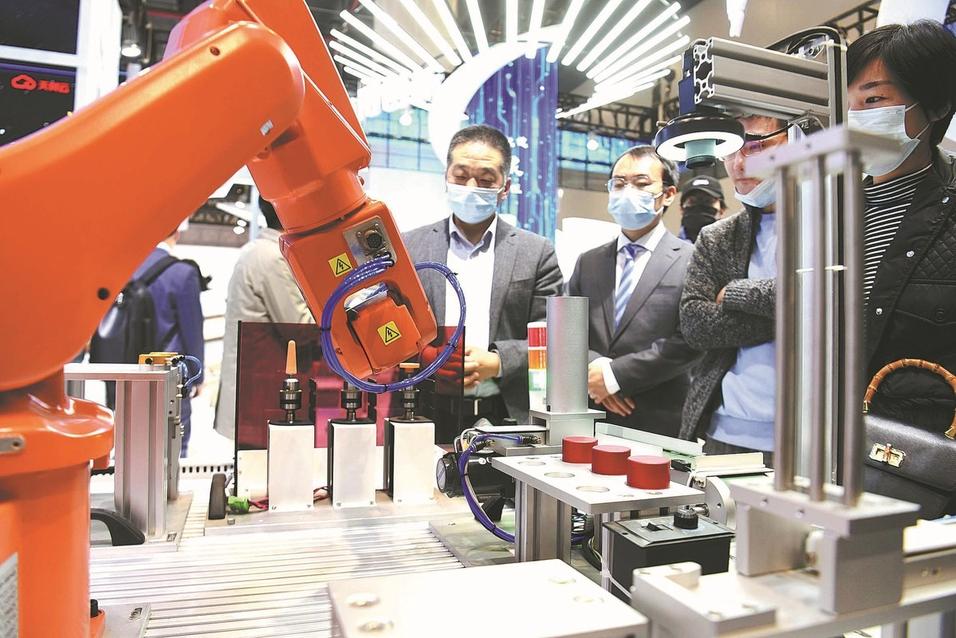 Visitors watch a demonstration of 5G tech's application in manufacturing at the 2022 China 5G plus Industrial Internet Conference in Wuhan, Hubei province, China. (GAO YONG / FOR CHINA DAILY)
Visitors watch a demonstration of 5G tech's application in manufacturing at the 2022 China 5G plus Industrial Internet Conference in Wuhan, Hubei province, China. (GAO YONG / FOR CHINA DAILY)
BEIJING – China's value-added industrial output, an important economic indicator, went up 2.2 percent year on year in November, data issued by the National Bureau of Statistics (NBS) showed on Thursday.
"The industrial output remained stable in November despite the short-term impact of the pandemic," said Tang Weiwei, an official with the NBS.
In the first 11 months, the mining output climbed by 7.6 percent compared with the previous year. The manufacturing sector's output rose 3.3 percent, and the production and supply of electricity, heat, gas and water went up 4.8 percent.
China's industrial transformation and upgrading trends have not changed.
Tang Weiwei, Official, NBS
In terms of products, the output of new energy vehicles registered a 60.5-percent year-on-year increase in November, while that of solar batteries increased 68.6 percent year on year, according to the NBS data.
"China's industrial transformation and upgrading trends have not changed," Tang said. The industrial production is expected to accelerate recovery as the optimization of COVID-19 prevention and control measures and the pro-growth measures are taking effect, he added.
ALSO READ: China's economy expected to further recover, said official
The industrial output is used to measure the activity of large enterprises each with an annual main business turnover of at least 20 million yuan (about $2.88 million).
The country’s fixed-asset investment meanwhile went up 5.3 percent year on year in the first 11 months of this year, according to the data.
Retail sales down
The country's retail sales of consumer goods edged down 0.1 percent over one year ago during the January-November period.
With the implementation of optimized COVID-19 response and pro-consumption measures, China's retail sales is expected to steadily recover, the NBS said in a statement.
Online retail sales during the time went up 4.2 percent year on year, the data showed.
While online sales of physical goods climbed by 6.4 percent accounting for 27.1 percent of the total retail sales of consumer goods, such sales of food and daily groceries rose 15.1 percent and 6.1 percent.
Brick-and-mortar stores offering daily necessities like convenience stores and groceries also posted positive retail growth during the period.
Urban unemployment 5.7%
China's surveyed urban unemployment rate stood at 5.7 percent in November, up from 5.5 percent in the previous month.
In the first 11 months of the year, the average surveyed urban unemployment rate was 5.6 percent, according to the NBS.
Home prices in China's 70 large and medium-sized cities eased in November, with fewer cities seeing a decline in home prices
The surveyed unemployment rate among those aged between 25 and 59, which constitute the majority of the labor market, came in at 5 percent in November, up from 4.7 percent in October.
The surveyed unemployment rate in 31 major cities was 6.7 percent last month, NBS data showed.
The surveyed urban unemployment rate is calculated based on the number of unemployed people who have participated in the employment survey in urban areas, including migrant workers in cities.
Property investment down
Investment in property development went down 9.8 percent year on year during the 11 months.
Total property investment in this period stood at 12.39 trillion yuan (about $1.79 trillion), the NBS said, adding that investment in residential buildings came in at 9.4 trillion yuan, down 9.2 percent year on year.
Commercial housing sales in terms of floor area totaled 1.21 billion square meters, down 23.3 percent year on year. In terms of value, sales fell 26.6 percent to 11.86 trillion yuan.
The property development climate index, compiled by the NBS, came in at 94.42 points in November.
Home prices ease
China's home prices in 70 large and medium-sized cities eased in November, with fewer cities seeing a decline in home prices, the NBS data showed.
In November, 51 out of the 70 cities saw a month-on-month drop in new home sales prices, compared with 58 in October. Total 62 cities witnessed a decrease in resale home prices, flat with the previous month.
READ MORE: China's home prices ease in October
New home prices in four first-tier cities – Beijing, Shanghai, Shenzhen and Guangzhou – edged down 0.2 percent month on month in November. The pace of decline accelerated 0.1 percentage points from the previous month, according to the data.
New home prices in 31 second-tier cities decreased 0.2 percent month on month, with the decline narrowing 0.1 percentage points from October, while 35 third-tier cities saw a month-on-month decline of 0.3 percent.


